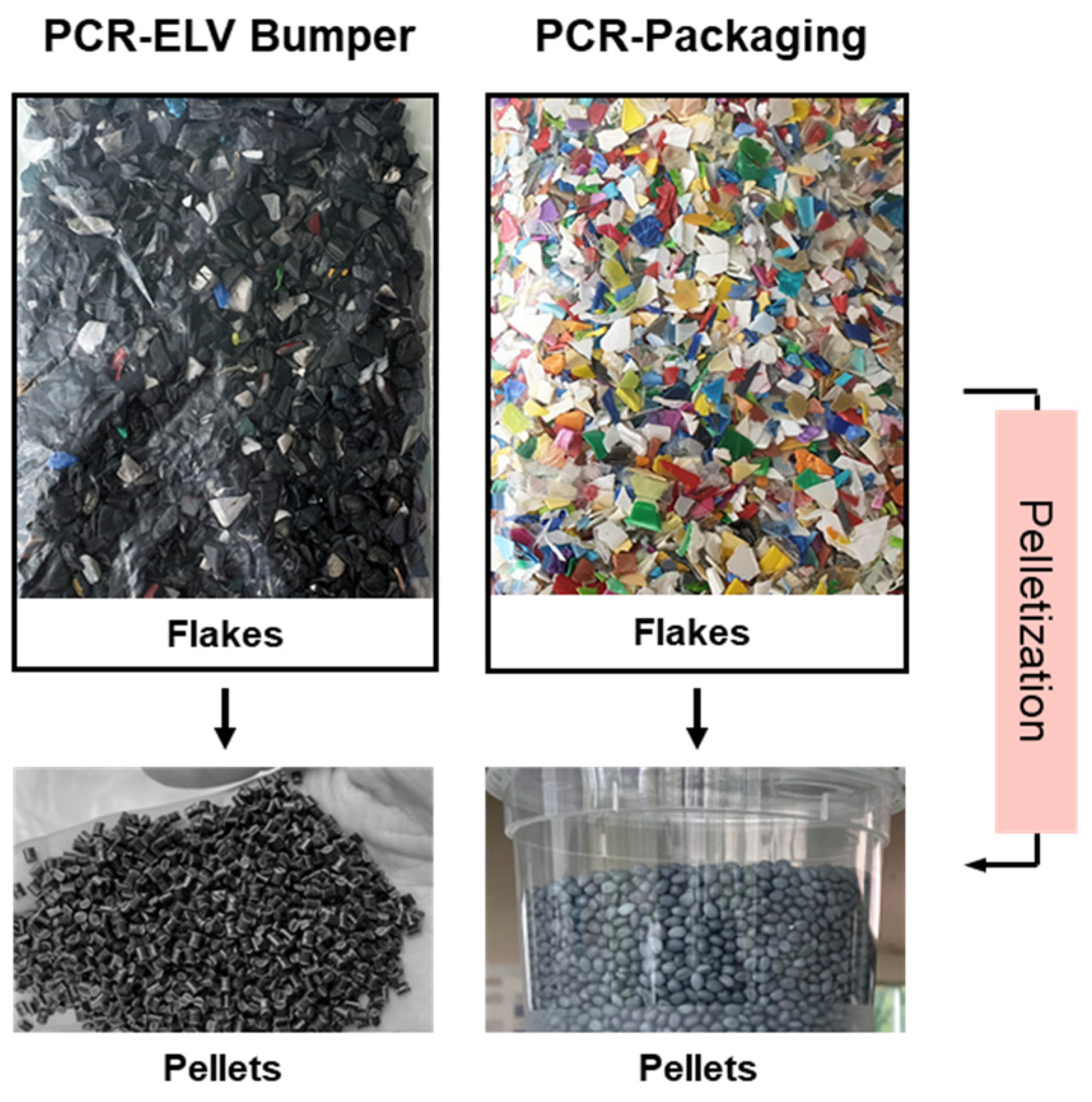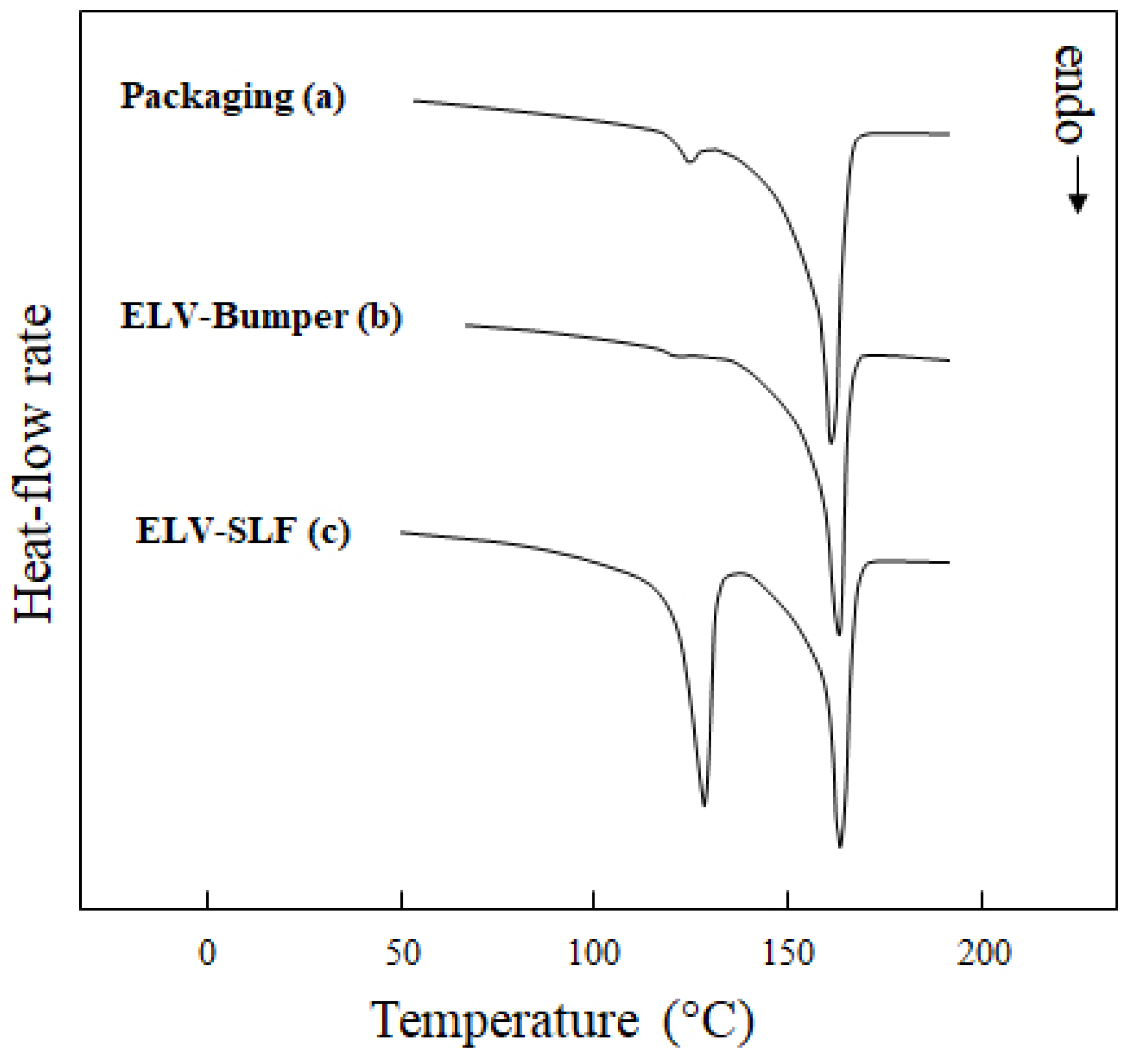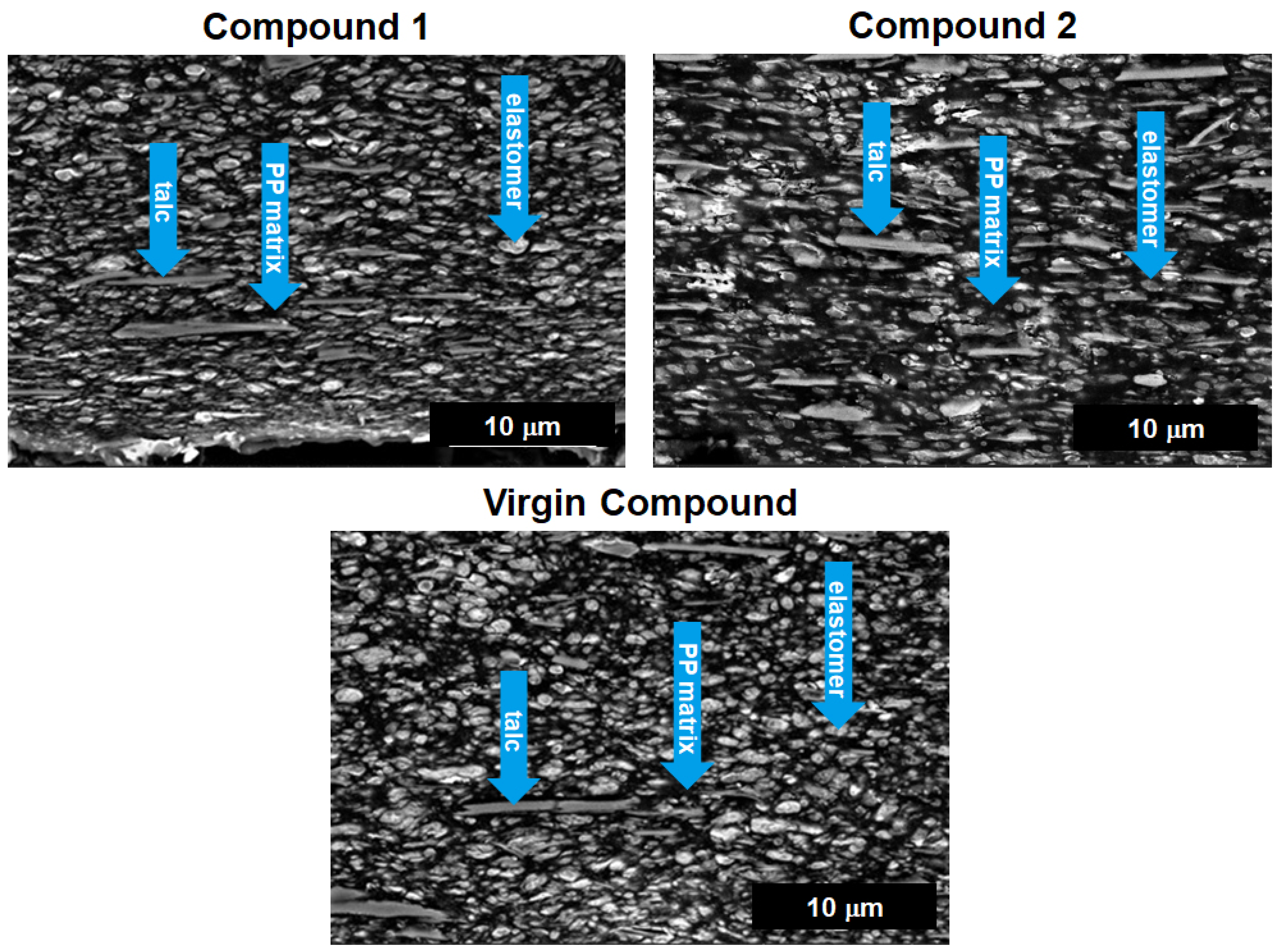Comparing End-of-Life Vehicle (ELV) and Packaging-Based Recyclates as Components in Polypropylene-Based Compounds for Automotive Applications
Abstract
:1. Introduction
- Analyzing semicommercially (i.e., as samples from pilot scale) available ELV recyclate grades based on bumper or ‘shredder light fraction’ (SLF) recycling in terms of composition and suitability for automotive compounds;
- Testing these as components in automotive compounds in direct comparison to a packaging-based post-consumer recyclate (PCR) already established as a compounding component.
2. Materials and Methods
2.1. Investigated Recyclates and Modifiers
2.2. Analytics and Mechanics
2.3. Compounding
3. Results
3.1. ELV and Packaging Recyclates
- The molecular weight of elastomer-like EPC, as well as its composition and content, is decisive for the stiffness-impact balance of impact copolymers and similar compositions [35,51]. The PCR-Packaging type clearly has the lowest C2(SF), related to a rather high glass transition temperature in the EPC phase [52]. This, in combination with the lowest amount of SF, is limiting the impact strength. Both ELV types are similar in that respect, and the IV(SF) representing the molecular weight of the EPC phase is very similar for all PCRs.
- The molecular weight of the crystalline fractions is the dominant factor for the MFR of the compositions, but it is also decisive for room-temperature toughness. Only the PCR-ELV-SLFtype shows a higher value for IV(CF), likely as a consequence of the high PE content. This is reflected by the highest Charpy NIS at 23 °C.
- Mineral filler content is decisive for the stiffness of the compositions, and the PCR-ELV-Bumper type also shows the highest flexural modulus. Secondary factors are EPC content and the PP/PE ratio, as the latter polymer is significantly less stiff.
3.2. Automotive Compounds
4. Summary and Conclusions
Author Contributions
Funding
Institutional Review Board Statement
Data Availability Statement
Conflicts of Interest
References
- Bernreitner, K.; Gahleitner, M.; Grestenberger, G.; Kahlen, S.; Niedersüß, P.; Tranninger, C. The Future of Polypropylene Lies in the Circular Economy. Kunststoffe Intern 2022, 10, 22–28. [Google Scholar]
- Plastics Europe, Plastics—The Facts 2022. Available online: https://plasticseurope.org/knowledge-hub/plastics-the-facts-2022/ (accessed on 15 May 2024).
- European Commission, 2023. Proposal for a Regulation of the European Parliament and of the Council on Circularity Requirements for Vehicle Design and on Management of End-of-Life Vehicles. Available online: https://environment.ec.europa.eu/publications/proposal-regulation-circularity-requirements-vehicle-design-and-management-end-life-vehicles_en (accessed on 15 May 2024).
- Systemiq, 2022. ReShaping Plastics: Pathways to a Circular, Climate Neutral Plastics System in Europe. Available online: https://www.systemiq.earth/systems/circular-materials/reshaping-plastics/ (accessed on 15 May 2024).
- Matos, J.; Santos, S.; Simões, C.L.; Martins, C.I.; Simoes, R. Practical application of circularity micro-indicators to automotive plastic parts in an industrial context. Sustain. Prod. Consum. 2023, 43, 155–167. [Google Scholar] [CrossRef]
- Geyer, R.; Jambeck, J.R.; Law, K.L. Production, use, and fate of all plastics ever made. Sci. Adv. 2017, 3, e1700782. [Google Scholar] [CrossRef] [PubMed]
- Van Eygen, E.; Feketitsch, J.; Laner, D.; Rechberger, H.; Fellner, J. Comprehensive analysis and quantification of national plastic flows: The case of Austria. Resour. Conserv. Recycl. 2017, 117, 183–194. [Google Scholar] [CrossRef]
- Kawecki, D.; Wu, Q.; Gonçalves, J.S.V.; Nowack, B. Polymer-specific dynamic probabilistic material flow analysis of seven polymers in Europe from 1950 to 2016. Resour. Conserv. Recycl. 2021, 173, 105733. [Google Scholar] [CrossRef]
- Di, J.; Reck, B.K.; Miatto, A.; Graede, T.E. United States plastics: Large flows, short lifetimes, and negligible recycling. Resour. Conserv. Recycl. 2021, 167, 105440. [Google Scholar] [CrossRef]
- Jiang, X.; Wang, T.; Jiang, M.; Xu, M.; Yu, Y.; Guo, B.; Chen, D.; Hu, S.; Jiang, J.; Zhang, Y.; et al. Assessment of Plastic Stocks and Flows in China: 1978–2017. Resour. Conserv. Recycl. 2020, 161, 104969. [Google Scholar] [CrossRef]
- Castro, M.B.G.; Remmerswaal, J.A.M.; Reuter, M.A. Life Cycle Impact Assessment of the Average Passenger Vehicle in the Netherlands. Int. J. Life Cycle Assess. 2003, 8, 297–304. [Google Scholar] [CrossRef]
- Inghels, D.; Dullaert, W.; Raa, B.; Walther, G. Influence of composition, amount and life span of passenger cars on end-of-life vehicles waste in Belgium: A system dynamics approach. Transp. Res. Part A Policy Pract. 2016, 91, 80–104. [Google Scholar] [CrossRef]
- Venkatachalam, V.; Pohler, M.; Spierling, S.; Nickel, L.; Barner, L.; Endres, H.-J. Design for Recycling Strategies Based on the Life Cycle Assessment and End of Life Options of Plastics in a Circular Economy. Macromol. Chem. Phys. 2022, 223, 2200046. [Google Scholar] [CrossRef]
- Guo, W.; Li, K.; Fang, Z.; Feng, T.; Shi, T. A sustainable recycling process for end-of-life vehicle plastics: A case study on waste bumpers. Waste Manag. 2022, 154, 187–198. [Google Scholar] [CrossRef] [PubMed]
- Gallone, T.; Zeni-Guido, A. Closed-Loop Polypropylene, an Opportunity for the Automotive Sector. J. Field Actions Spec. Issue 2019, 19, 48–53. Available online: https://journals.openedition.org/factsreports/5225 (accessed on 2 May 2024).
- Yin, S.; Tuladhar, R.; Shi, F.; Shanks, R.A.; Combe, M.; Collister, T. Mechanical Reprocessing of Polyolefin Waste: A Review. Polym. Eng. Sci. 2015, 55, 2899–2909. [Google Scholar] [CrossRef]
- Ragaert, K.; Delva, L.; Van Geem, K. Mechanical and chemical recycling of solid plastic waste. Waste Manag. 2017, 68, 24–58. [Google Scholar] [CrossRef] [PubMed]
- Schyns, Z.O.G.; Shaver, M.P. Mechanical Recycling of Packaging Plastics: A Review. Macromol. Rapid Commun. 2020, 42, 2000415. [Google Scholar] [CrossRef] [PubMed]
- Kaiser, K.; Schmid, M.; Schlummer, M. Recycling of Polymer-Based Multilayer Packaging: A Review. Recycling 2018, 3, 1. [Google Scholar] [CrossRef]
- Roosen, M.; Mys, N.; Kleinhans, K.; Lase, I.S.; Huysveld, S.; Brouwer, M.; van Velzen, E.U.T.; Van Geem, K.M.; Dewulf, J.; Ragaert, K.; et al. Expanding the collection portfolio of plastic packaging: Impact on quantity and quality of sorted plastic waste fractions. Resour. Conserv. Recycl. 2022, 178, 106025. [Google Scholar] [CrossRef]
- Seier, M.; Archodoulaki, V.-M.; Koch, T.; Duscher, B.; Gahleitner, M. Prospects for Recyclable Multilayer Packaging: A Case Study. Polymers 2023, 15, 2966. [Google Scholar] [CrossRef]
- Seier, M.; Archodoulaki, V.-M.; Koch, T. The morphology and properties of recycled plastics made from multi-layered packages and the consequences for the circular economy. Resour. Conserv. Recycl. 2024, 202, 107388. [Google Scholar] [CrossRef]
- Van Belle, A.; Demets, R.; Mys, N.; Van Kets, K.; Dewulf, J.; Van Geem, K.; De Meester, S.; Ragaert, K. Microstructural Contributions of Different Polyolefins to the Deformation Mechanisms of Their Binary Blends. Polymers 2020, 12, 1171. [Google Scholar] [CrossRef]
- Demets, R.; Grodent, M.; Van Kets, K.; De Meester, S.; Ragaert, K. Macromolecular Insights into the Altered Mechanical Deformation Mechanisms of Non-Polyolefin Contaminated Polyolefins. Polymers 2022, 14, 239. [Google Scholar] [CrossRef] [PubMed]
- Gall, M.; Freudenthaler, P.J.; Fischer, J.; Lang, R.W. Characterization of Composition and Structure–Property Relationships of Commercial Post-Consumer Polyethylene and Polypropylene Recyclates. Polymers 2021, 13, 1574. [Google Scholar] [CrossRef] [PubMed]
- Mehrabi-Mazidia, M.; Sharif, H. Post-consumer recycled high density polyethylene/polypropylene blend with improved overall performance through modification by impact polypropylene copolymer: Morphology, properties and fracture resistance. Polym. Int. 2021, 70, 1701–1716. [Google Scholar] [CrossRef]
- Robson, S.; Goodhead, T.C. A process for incorporating automotive shredder residue into thermoplastic mouldings. J. Mater. Process. Technol. 2003, 139, 327–331. [Google Scholar] [CrossRef]
- Luda, M.P.; Ragosta, G.; Musto, P.; Acierno, D.; Di Maio, L.; Camino, G.; Nepote, V. Regenerative Recycling of Automotive Polymer Components: Poly(propylene) Based Car Bumpers. Macromol. Mater. Eng. 2003, 288, 613–620. [Google Scholar] [CrossRef]
- Rabeau Epsztein, S.; Jevardat de Fombelle, M.-A.; Falher, T.; Jouannet, D.; Gallone, T.; Cauret, L. Substitution of Virgin material by recycled material from End-of-Life Vehicle (ELV). Key Eng. Mater. 2014, 611–612, 836–843. [Google Scholar] [CrossRef]
- Kozderka, M.; Rose, B.; Bahlouli, N.; Kočí, V.; Caillaud, E. Recycled high impact polypropylene in the automotive industry—mechanical and environmental properties. Int. J. Interact. Des. Manuf. 2017, 11, 737–750. [Google Scholar] [CrossRef]
- Yang, S.; Bai, S.; Duan, W.; Qi Wang, Q. Preparation of composites based on recycled polypropylene and automotive shredder residue. Polym. Int. 2018, 67, 936–945. [Google Scholar] [CrossRef]
- Jahromi, F.T.; Nikzad, M.; Prasad, K.; Norén, J.; Isaksson, M.; Arian, A.; Sbarski, I. Additive manufacturing of polypropylene micro and nano composites through fused filament fabrication for automotive repair applications. Polym. Adv. Technol. 2023, 34, 1059–1074. [Google Scholar] [CrossRef]
- Ghabezi, P.; Sam-Daliri, O.; Flanagan, T.; Walls, M.; Harrison, N.M. Circular economy innovation: A deep investigation on 3D printing of industrial waste polypropylene and carbon fibre composites. Resour. Conserv. Recycl. 2024, 206, 107667. [Google Scholar] [CrossRef]
- Galli, P.; Milani, F.; Simonazzi, T. New Trends in the Field of Propylene Based Polymers. Polym. J. 1985, 17, 37–55. [Google Scholar] [CrossRef]
- Gahleitner, M.; Doshev, P.; Tranninger, C. Heterophasic copolymers of polypropylene—Development, design principles and future challenges. J. Appl. Polym. Sci. 2013, 130, 3028–3037. [Google Scholar] [CrossRef]
- Yu, T.C. Metallocene plastomer modification of polypropylenes. Polym. Eng. Sci. 2001, 41, 656–671. [Google Scholar] [CrossRef]
- McNally, T.; McShane, P.; Nally, G.M.; Murphy, W.R.; Cook, M.; Miller, A. Rheology, phase morphology, mechanical and thermal properties of polypropylene/ metallocene catalysed ethylene 1-octene copolymer blends. Polymer 2020, 43, 3785–3793. [Google Scholar] [CrossRef]
- ISO 1133-1:2022; Plastics—Determination of the Melt Mass-Flow Rate (MFR) and Melt Volume-Flow Rate (MVR) of Thermoplastics, Part 1: Standard Method. International Standard Organization: Geneva, Switzerland, 2019.
- ISO 11357-3:2018; Plastics—Differential Scanning Calorimetry (DSC), Part 3: Determination of Temperature and Enthalpy of Melting and Crystallization. International Standard Organization: Geneva, Switzerland, 2018.
- ISO 1183-1:2019; Plastics—Methods for Determining the Density of Non-Cellular Plastics, Part 1: Immersion Method, Liquid Pycnometer Method and Titration Method. International Standard Organization: Geneva, Switzerland, 2019.
- ISO 1172:1996; Textile-Glass-Reinforced Plastics—Prepregs, Moulding Compounds and Laminates—Determination of the Textile-Glass and Mineral-Filler Content Using Calcination Methods. International Standard Organization: Geneva, Switzerland, 1996.
- Jeremic, L.; Albrecht, A.; Sandholzer, M.; Gahleitner, M. Rapid characterization of high-impact ethylene–propylene copolymer composition by crystallization extraction separation: Comparability to standard separation methods. Int. J. Polym. Anal. Charact. 2020, 25, 581–596. [Google Scholar] [CrossRef]
- ISO 11359-2:2021; Plastics—Thermomechanical analysis (TMA), Part 2: Determination of Coefficient of Linear Thermal Expansion and Glass Transition Temperature. International Standard Organization: Geneva, Switzerland, 2021.
- ISO 19069-2:2016; Plastics—Polypropylene (PP) Moulding and Extrusion Materials, Part 2: Preparation of Test Specimens and Determination of Properties. International Standard Organization: Geneva, Switzerland, 2016.
- ISO 178:2019; Plastics—Determination of Flexural Properties. International Standard Organization: Geneva, Switzerland, 2019.
- ISO 179-1:2010; Plastics—Determination of Charpy Impact Properties, Part 1: Non-Instrumented Impact Test. International Standard Organization: Geneva, Switzerland, 2010.
- ISO 6603-2:2023; Plastics—Determination of Puncture Impact Behaviour of Rigid Plastics, Part 2: Instrumented Impact Testing. International Standard Organization: Geneva, Switzerland, 2023.
- Poelt, P.; Ingolic, E.; Gahleitner, M.; Bernreitner, K.; Geymayer, W. Characterization of modified polypropylene by scanning electron microscopy. J. Appl. Polym. Sci. 2000, 78, 1152–1162. [Google Scholar] [CrossRef]
- Wunderlich, B.; Czornyj, G. A Study of Equilibrium Melting of Polyethylene. Macromolecules 1977, 10, 906–913. [Google Scholar] [CrossRef]
- Lanyi, F.J.; Wenzke, N.; Kaschta, J.; Schubert, D.W. On the Determination of the Enthalpy of Fusion of α-Crystalline Isotactic Polypropylene Using Differential Scanning Calorimetry, X-Ray Diffraction, and Fourier-Transform Infrared Spectroscopy: An Old Story Revisited. Adv. Eng. Mater. 2020, 22, 1900796. [Google Scholar] [CrossRef]
- Grein, C.; Bernreitner, K.; Hauer, A.; Gahleitner, M.; Neißl, W. Impact Modified Isotatic Polypropylene with Controlled Rubber Intrinsic Viscosities: Some New Aspects About Morphology and Fracture. J. Appl. Polym. Sci. 2003, 87, 1702–1712. [Google Scholar] [CrossRef]
- Doshev, P.; Lohse, G.; Henning, S.; Krumova, M.; Heuvelsland, A.; Michler, G.; Radusch, H.-J. Phase Interactions and Structure Evolution of Heterophasic Ethylene–Propylene Copolymers as a Function of System Composition. J. Appl. Polym. Sci. 2006, 101, 2825–2837. [Google Scholar] [CrossRef]
- Moritomi, S.; Watanabe, T.; Kanzaki, S. Polypropylene Compounds for Automotive Applications, Sumitomo Kagaku (English Edition), Report 1. 2010. Available online: https://www.sumitomo-chem.co.jp/english/rd/report/files/docs/01_2010-1e.pdf (accessed on 10 October 2023).
- Grestenberger, G.; Potter, G.D.; Grein, C. Polypropylene/ethylene-propylene rubber (PP/EPR) blends for the automotive industry: Basic correlations between EPR-design and shrinkage. Exp. Polym. Lett. 2014, 8, 282–292. [Google Scholar] [CrossRef]






| PCR-Packaging | PCR-ELV-Bumper | PCR-ELV-SLF | ||
|---|---|---|---|---|
| MFR 1 | g/10 min | 25 | 12 | 8 |
| Density | kg/m3 | 910 | 1020 | 930 |
| Ash 2 | wt.-% | 1.5 | 18 | 3.0 |
| DSC | ||||
| Tm,PE | °C | 124 | 124 | 128 |
| Hm,PE | J/g | 2.5 | 0.4 | 56.6 |
| Tm,PP | °C | 163 | 165 | 163 |
| Hm,PP | J/g | 95.8 | 56.6 | 52.1 |
| CRYSTEX | ||||
| SF | wt.-% | 10 | 34 | 20 |
| C2 total | wt.-% | 5.8 | 23 | 29 |
| C2(SF) | wt.-% | 26 | 50 | 41 |
| C2(CF) | wt.-% | 3.5 | 10 | 27 |
| IV total | dl/g | 1.60 | 1.66 | 1.95 |
| IV(SF) | dl/g | 1.71 | 1.75 | 1.74 |
| IV(CF) | dl/g | 1.62 | 1.63 | 1.96 |
| Mechanics | ||||
| Flexural modulus | MPa | 1324 | 1587 | 637 |
| NIS +23 °C | kJ/m2 | 5.0 | 34 | 46 |
| NIS −20 °C | kJ/m2 | 2.2 | 6.6 | 8.8 |
| IPT +23 °C Emax | J | 3 | 18 | 18 |
| IPT +23 °C Epunct | J | 4 | 29 | 29 |
| IPT −30 °C Emax | J | n.d. | 16 | 13 |
| IPT −30 °C Epunct | J | n.d. | 17 | 14 |
| CLTE +23/80 °C | µm/m°C | 123 | 55 | n.d. |
| CLTE −30/80 °C | µm/m°C | 100 | 46 | n.d. |
| Virgin Polyolefin Mix 1 | Virgin Polyolefin Mix 2 | ||
|---|---|---|---|
| MFR 1 | g/10 min | 7.7 | 9.6 |
| CRYSTEX | |||
| SF | wt.-% | 39 | 30 |
| C2 total | wt.-% | 26 | 12 |
| C2(SF) | wt.-% | 55 | 37 |
| C2(CF) | wt.-% | 5.0 | 5.0 |
| IV total | dL/g | 1.8 | 1.9 |
| IV(SF) | dL/g | 2.9 | 3.53 |
| IV(CF) | dL/g | 1.5 | 1.5 |
| Packaging-PCR Compound 1 | ELV-PCR Compound 2 | Virgin Compound 1 | ||
|---|---|---|---|---|
| Virgin polyolefin mix 1 | wt.-% | 58.25 | - | |
| Virgin polyolefin mix 2 | wt.-% | 49.25 | - | |
| PCR-Packaging | wt.-% | 25.0 | - | |
| PCR-ELV-Bumper | wt.-% | 40.0 | ||
| Talc | wt-% | 15.0 | 9.0 | - |
| Additives | wt.-% | 1.75 | 1.75 | - |
| MFR 2 | g/10 min | 10 | 9.0 | 22 |
| Ash 3 | wt.-% | 15.1 | 17.1 | 15.0 |
| CRYSTEX | ||||
| SF | wt.-% | 30 | 31 | - |
| C2 total | wt.-% | 18 | 16 | - |
| C2 (SF) | wt.-% | 50 | 42 | - |
| C2 (CF) | wt.-% | 5.0 | 7.0 | - |
| IV total | dL/g | 1.8 | 1.9 | - |
| IV (SF) | dL/g | 2.6 | 2.6 | - |
| IV (CF) | dL/g | 1.5 | 1.7 | - |
| Mechanics | ||||
| Flexural modulus | MPa | 1459 | 1608 | 1750 |
| NIS +23 °C | kJ/m2 | 54 | 43 | 40 |
| NIS −20 °C | kJ/m2 | 5.9 | 6 | 6 |
| IPT +23 °C Emax | J | 20 | 20 | 22 |
| IPT +23 °C Epunct | J | 37 | 34 | 36 |
| IPT −30 °C Emax | J | 35 | 17 | 21 |
| IPT −30 °C Epunct | J | 43 | 18 | 31 |
| CLTE +23/80 °C | µm/m°C | 90 | 76 | 71 |
| CLTE −30/80 °C | µm/m°C | 75 | 65 | 56 |
Disclaimer/Publisher’s Note: The statements, opinions and data contained in all publications are solely those of the individual author(s) and contributor(s) and not of MDPI and/or the editor(s). MDPI and/or the editor(s) disclaim responsibility for any injury to people or property resulting from any ideas, methods, instructions or products referred to in the content. |
© 2024 by the authors. Licensee MDPI, Basel, Switzerland. This article is an open access article distributed under the terms and conditions of the Creative Commons Attribution (CC BY) license (https://creativecommons.org/licenses/by/4.0/).
Share and Cite
Gall, M.; Mileva, D.; Stockreiter, W.; Salles, C.; Gahleitner, M. Comparing End-of-Life Vehicle (ELV) and Packaging-Based Recyclates as Components in Polypropylene-Based Compounds for Automotive Applications. Polymers 2024, 16, 1927. https://doi.org/10.3390/polym16131927
Gall M, Mileva D, Stockreiter W, Salles C, Gahleitner M. Comparing End-of-Life Vehicle (ELV) and Packaging-Based Recyclates as Components in Polypropylene-Based Compounds for Automotive Applications. Polymers. 2024; 16(13):1927. https://doi.org/10.3390/polym16131927
Chicago/Turabian StyleGall, Markus, Daniela Mileva, Wolfgang Stockreiter, Christophe Salles, and Markus Gahleitner. 2024. "Comparing End-of-Life Vehicle (ELV) and Packaging-Based Recyclates as Components in Polypropylene-Based Compounds for Automotive Applications" Polymers 16, no. 13: 1927. https://doi.org/10.3390/polym16131927





